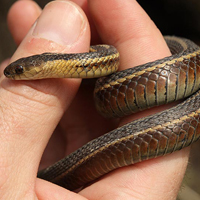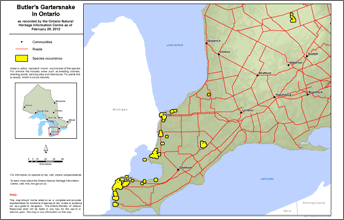Butler’s Gartersnake
Scientific name: Thamnophis butleri

Status
Endangered
“Endangered” means the species lives in the wild in Ontario but is facing imminent extinction or extirpation.
Date added to the Species at Risk in Ontario List
The Butler’s Gartersnake was already assessed as endangered when the Endangered Species Act took effect in 2008.
Read the Assessment Report
What it looks like
The Butler’s Gartersnake is a small, non-venomous snake, 25 to 57 centimetres long. It has a tiny head and yellow to orange stripes running lengthwise on a dark brown-black background. It looks very similar to the Common Gartersnake and is difficult to distinguish.
Where it lives
The Butler’s Gartersnake prefers open, moist habitats, such as dense grasslands and old fields, with small wetlands where it can feed on leeches and earthworms.
Burrows made by small mammals and even crayfish are sometimes used as hibernation sites, called hibernacula. This species is also commonly found in rock piles or old stonewalls.
Where it’s been found in Ontario
The only place in the world where Butler’s Gartersnake is found is in the lower Great Lakes region. In Ontario, this snake is concentrated in two areas, within 10 kilometres of the Detroit River, Lake St. Clair, the St. Clair River, and Lake Huron from Amherst Point to Errol, in Essex and Lambton counties Luther Marsh, Dufferin and Wellington counties.
Population sizes can vary. Estimates done at several sites in Ontario in 1997 ranged between 50 and 900 snakes. At some sites it is considered to be locally common.
View a larger version of this map (PDF)
What threatens it
The most significant threat to the Butler’s Gartersnake is the loss of tallgrass prairie and other grassland habitat due to development in the highly urbanized areas where this species exists.
Habitat fragmentation is also a problem since this sedentary snake is unlikely to cross large stretches of unsuitable habitat. Road mortality is another threat.
Action we are taking
Endangered Species and their general habitat are automatically protected.
Recovery strategy
A recovery strategy advises the ministry on ways to ensure healthy numbers of the species return to Ontario.
Read the executive summary and the full document (July 22, 2019)
Government response statement
A government response statement outlines the actions the government intends to take or support to help recover the species.
Read the government response statement (April 23, 2020)
Habitat protection
General Habitat Protection - June 8, 2011
What you can do
Report a sighting
- Report a sighting of an endangered animal or plant to the Natural Heritage Information Centre. Photographs with specific locations or mapping coordinates are always helpful.
Volunteer
Volunteer with your local nature club or provincial park to participate in surveys or stewardship work focused on species at risk.
Be a good steward
- Private land owners have a very important role to play in species recovery. If you find a Butler’s Gartersnake on your land, you may be eligible for stewardship programs that support the protection and recovery of species at risk and their habitats.
- If you come across a snake, please don’t try to capture it, handle it or kill it. Snakes can be delicate and improper handling can cause serious injury. Also, certain species are protected under legislation, which makes it illegal to harass, harm or kill them. Be respectful and observe from a distance.
- Visit the Ontario Reptile and Amphibian Atlas or Toronto Zoo Adopt-a-pond-website to learn more about Ontario’s rare snakes, their habitat and related conservation initiatives.
- Watch for snakes that may be crossing roads between May and October. Road mortality is a serious threat to snakes because they are slow moving, hard to see on the road and are sometimes intentionally run over. If it is safe to do so, help snakes across the road in the direction they were headed.
- Although species at risk are protected, poachers have been known to capture individuals for the pet or food trade. Butler’s Gartersnake may be inadvertently advertised and sold as a Common Gartersnake in pet stores, due to its close resemblance to this and other gartersnakes. Never buy snakes that have been caught in the wild and never buy a native species of any kind that’s being sold as a pet.
Report illegal activity
Report any illegal activity related to plants and wildlife to
Quick facts
- The Butler’s Gartersnake is non-venomous, as are all of Ontario’s snakes except for the rare Massassauga rattlesnake. The gentle Butler’s Gartersnake will never bite unless handled roughly.
- The Butler’s Gartersnake exhibits a peculiar behaviour called side-winding. When excited, it will vigorously wriggle from side to side, making little forward progress.
- This species feeds primarily on earthworms, which are not native to Ontario and were introduced by Europeans.
- The Butler’s Gartersnake is “ovoviviparous”, which means it gives birth to live young! Instead of laying eggs in nesting material, the eggs are incubated inside the female. Females give birth in mid-to late summer to four to 20 young that are smaller than a pencil.
